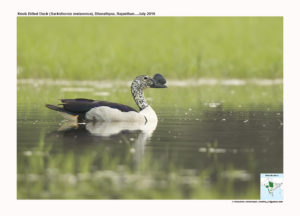Knob-billed Duck

Knob-billed Duck Sarkidiornis melanotos
Etymology:
- Sarkidiornis : sarkidion small piece of flesh ; ornis bird
- Melanotos : Greek word melas black ; notos –backed { Black Backed}
Vernacular Names : Sind: Karo hanj, Hindi: Nakta, Pun: Nakta, Bi: Nakwa, Ben: Nakta, Guj: Nakta, Mar: Nakta, Ori: Naki hansa, Ta: Mookkan thara, Te: Juttu chiluwa, Kan: Dodda sarle hakki, Mal: Muzhayan thaaraavu, Sinh: Kabalittiya
Distribution in India: Wide spread Resident in Central & North India, Gujrat, Some parts of western Ghats and sporadically in East and South India in its habitat area.
Description: Size of 64–79 cm; wt. of male 1300–2610 g, female 1230–2325 g.. Adults have a white head freckled with dark spots, and a pure white neck and underparts. The upperparts are glossy blue-black upperparts, with bluish and greenish iridescence especially prominent on the secondaries. The male is much larger than the female, and has a large black knob on the bill. The juvenile dark brownish above, with pale buff-brown neck and underparts, and dark brown spotting on flanks and breast; subsequently resembles female, but is less glossy above and heavily barred blackish on hindneck.
Habitat: It is found in freshwater swamps, rivers and their deltas, lakes, rice fields, inundated floodplains, all with thinly scattered trees; also in more open grasslands.
Food Habits: It eats seeds and vegetative parts of grasses, sedges and aquatic vegetation; occasionally water insects and their larvae, worms and molluscs and water snails. Grazes on land and swims, dabbles, upends and wades in shallow water.
Breeding Habits: They breed in Jul–Sept in India. Pair-bonds probably entirely temporary. In single pairs or small groups, with males sometimes having harems of up to four females of which one is dominant. All females may lay in same nest. The nest is a site chosen by female .It is a rough structure of twigs and coarse grass, lined with fine grass, leaves and feathers, built in tree or rock hollows, occasionally on ground in reed beds. May re-use same tree cavity in subsequent seasons. It lays a clutch of 6–20 eggs. The incubation period is 28–30 days, starting with last egg, by female alone. All chicks hatch precocial. The fledging period is 10 weeks.